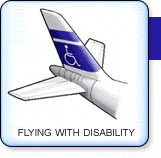|
|
Flying With Disability
| Flying with a wheelchair & other mobility aids |
|
Airlines, in line with the FAA safety regulations, must allow travellers dependent upon assistive devices carriage of such items.
These will in no way constitute a component of the individual's carry-on weight limit.
Smaller items such as canes and lighter wheel chairs, may be stored on board the passenger section of the aircraft.
Always book your flight as early as possible, not only will this save you money, but it gives you plenty of time to inform the airline that you are flying with a wheelchair.
When booking be sure to inform the airline that you are travelling in a wheelchair, so that they reserve you an aisle chair, making it easier to get into your chair (and out again).
If you are embarking on a particularly long flight, and will be unable to walk to the restroom, then ensuring that you reserve an aisle seat is essential.
Bearing in mind how small airplane toilet seats are, it is worth checking to see if the plane has a privacy curtain for the toilet.
Wide body jets are now more common for many international routes, and these will provide a wide enough berth to accommodate a special aisle chair to move to and from the toilet. As always, stay in contact with your airline and ask if your plane will have an aisle chair.
An aisle chair, is a specially designed seat to assist a person used to travelling in a wheelchair up and down the aisle of the aircraft. These are often very narrow, with a straight back, which can be wheeled along up and down the aisle of the aircraft.
It may be the case that the same route has wide berth planes for only a portion of its routes, in which case it makes sense to try and book onto one of these flights.
Most modern planes have space designated for a folding wheelchair, or its components. These items have priority on board over other passengers' carry-on goods, assuming they board the aircraft no already carrying passengers from a prior leg.
Wheelchairs and other assistive devices are always given priority on the whole, and will always be the first items to be unloaded from the aircraft. They will be returned to the traveller as soon as possible and as close to the door of the aircraft as regulations permit.
If the wheelchair is too large to be stowed in passenger area of the aircraft, and it is the case that the chair needs to be disassembled for the duration of the flight, then the airline are responsible for returning your chair in its original condition.
If the chair is electric, then certain further regulations exist. An electric wheelchair will be carried in line with those regulations regarding the passage of dangerous material. This is because the battery is considered a hazard.
The Air Carrier Access regulation make the distinction between spillable and non-spillable batteries. Wheelchairs powered by spillable batteries must be entirely removed, unless the wheelchair will be stored upright for the duration of the journey, and is attached to the chair.
Non-spillable batteries do not have to be removed, unless it is believed that the battery is damaged and leakage of battery fluid is possible.
It is the airline's responsibility to determine whether a battery is spillable or non-spillable. It is important to note that airlines cannot charge to pack batteries.
Flying in a stretcher
Larger, international airlines can nowadays accommodate travellers in stretchers, though you will have to fly with the necessary medical supervision.
Sadly, carriage of a stretcher often entails the purchase of 6-9 seats to cover the airline's cost of lost seating.
Naturally, medical clearance is essential, and we recommend you contact the relevant airline as early as possible to inform them that you will need to fly in a stretcher.
|
|
|
